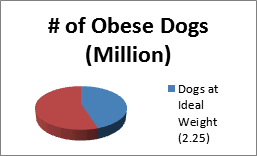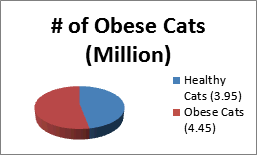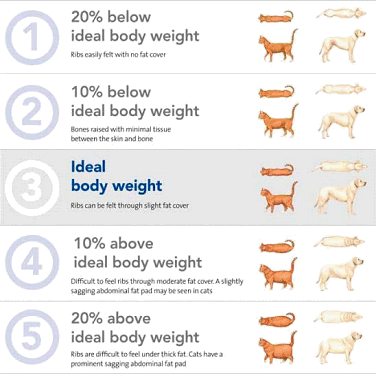| | Return to Pet Food Alberta Home Page
Pets are a popular household family member. In 2010 there were an estimated five million dogs and 8.4 million cats in Canada. Since owning a pet is gaining popularity, it is important to address pet health to maximize the well-being and lifespan of each animal.
Several health issues are on the rise in the dog and cat population. The largest threat to pets is the increase of obesity, and veterinarians and pet owners are concerned with this development.
 
*These numbers are based on US pet obesity percentages (55% of dogs and 53% of cats).
No Canadian percentages were known at the time this document was created.
Body weight over ideal conditions can fall into one of two categories:
Overweight means being 10-19% over the ideal body weight of the particular body size - it does not relate to the amount of body fat alone. Overweight can also result from larger muscle mass, larger bone density, and too much water retention.
Obesity means the body has an excess amount of body fat to the point that movement and health are impacted – roughly 20-25% above the ideal body weight of the breed.
How do we measure this?
The most common system of measuring obesity is the body condition scoring system (BCS). The BCS system ranges from 1-5,with the numbers corresponding to the following conditions
1 = Underweight, 2 = Thin (appears healthy)
3 = Normal, 4 = Overweight, 5 = Obese 
*Taken from http://www.canobolasvet.com/site/view/187249_Bodyconditionchart.pml
Dogs
Some breeds are more at risk of developing obesity than other breeds due to their genetics.
Did you know????
Boxers, Labrador Retrievers, King Charles Spaniels, Cocker Spaniels, Beagles, Dachshunds, and Basset Hounds are all at risk for developing obesity?
Did you know????
Obesity in dogs is related to obesity in their owners. – M.L. Nijland et al.
What about Cats?
Fewer cat than dog breeds are at risk for developing obesity. The main cat breed at risk is the domestic short-haired.
Did you know???
Daily caloric needs
10-lb. dog . . ... . . . . . . . . . .300 calories
20-lb. dog . . . . . . . . . . . . . .500 calories
50-lb. dog . . . . . . . . . . . ..1,200 calories
10-lb. cat . . . . .. . . . . . . . . .275 calories
How can you determine if your pet is at risk?
Your pet is a healthy weight IF. . .
üThe stomach doesn’t sag
üThe outline of a waist is noticed easily from above
üThe ribs are easily felt
Your pet is overweight IF . . .
üThe stomach sags – easy to grab a handful of fat
üThe back is broad and fat
üThe waist not visible from above
üRibs cannot be felt under the fat
Did you know????
Treats have a high caloric content and should be kept to a minimum. Make sure to follow any recommendations on the packaging.
Diseases associated with pet obesity:
üDiabetes
üArthritis
üBladder problems
üExercise intolerance
üHeat Intolerance
üHeart problems
üDifficult pregnancy and birth
üThyroid problems
üLowered immunity
üRespiratory problems
üShortened lifespan
What can you do?
It is quite simple for your pet to maintain a healthy weight. The animal’s calorie/energy intake must equal their energy expenditure. Owners can ensure that they exercise their pets on a regular basis. Owners must also control the number of meals and portion sizes that they are feeding their pets
Neutering and spaying your pet can increase their risk for developing obesity – to combat this, exercise and proper diet is necessary.
For your pet to maintain a healthy weight look for food higher in protein and fiber, and lower in fat. This helps promote muscle growth and repair, as well as ensures proper digestion.
Tips to decrease the risk of obesity
ü When you are making yourself a snack, don’t give in to those cute eyes begging you for food.
ü Make exercising with your pet fun! Both you and your pet will benefit from the experience with better health and a stronger bond.
ü One can also seek help for their pet through the use of pharmaceutical drugs – you must speak with your veterinarian regarding this treatment.
Other Useful Sources of Information:
References:
Butterwick R. How Fat is That Cat? Journal of Feline Medicine and Surgery. 2000, Vol.2, p.91-94
Butterwick R.F. & Hawthorne A.J. Advances in Dietary Management of Obesity in Dogs and Cats. The Journal of Nutrition, American Society of Nutrition. 1998, p2771s-2775s.
German A.J. The Growing Problem of Obesity in Dogs and Cats. The Journal of Nutrition, American Society of Nutrition. 2006, p1940s-12946s.
German A.J., Holden S., Bissot T., Morris P.J., Biourge V. A High Protein High Fibre Diet Improves Weight Loss in Obese Dogs. The Veterinary Journal. 2010, Vol. 183, p.294-297.
German A.J., Holden S., Bissot T., Morris P.J., Biourge V. Changes in Body Condition During Weight Loss in Obese Client-owned Cats: Loss of Lean Tissue Mass Correlates with Overall Percentage of Weight Loss. Journal of Feline Medicine and Surgery. 2008, Vol.10, p.452-459.
German A.J., Holden S., Morris P.J., Biourge V. Long-Term Follow-up After Weight Management in Obese Dogs: The Role of Diet in Preventing Regain. The Veterinary Journal. 2012, Vol. 192, p.65-70.
German A.J., Holden S.L., Weisman-Orr M.L., Reid J., Nolan A.M., Biourge V., Morris P.J. Quality of Life is Reduced in Obese Dogs but Improves After Successful Weight Loss. The Veterinary Journal. 2012, Vol. 192, p.428-434.
Gilor C., Graves T.K., Lascelles D.X., Thomson A.E., Simpson W., Halpern D.S. The Effects of Body Weight, Body Condition Score, Sex, and Age on Serum Fructosamine Concentrations in Clinically Healthy Cats. Veterinary Clinical Pathology. 2010, Vol. 39, No. 3, p.322-328.
Laflamme D.P., Companion Animals Symposium: Obesity in Dogs and Cats: What is Wrong with Being Fat? Journal of Animal Science. October 2011, Vol. 90, p.1653-1662.
Laflamme D.P., Understanding and Managing Obesity on Dogs and Cats. Veterinary Clinic of Small Animals Journal. August 2006, p.1283-1295.
Nijland M.L., Stam F. & Seidell J.C. Overweight in Dogs, but Not in Cats, Is Related to Overweight in their Owners. Journal of Public Health Nutrition. June 2009, Vol. 13(1) p.102-106.
Ricci R., Bevilacqa F. The Potential Role of Leptin and Adiponectin in obesity: A Comparative Review. The Veterinary Journal. 2012, Vol. 191, p.292-298.
Scott-Moncrieff J.C. Insulin Resistance in Cats. Veterinary Clinic of Small Animals Journal. 2010, Vol. 40 p.241-257.
Tvarijonaviciute A., Tecles F, Ceron J.J. Relationship Between Serum Butyrylcholinesterase and Obesity in Dogs: A Preliminary Report. The Veterinary Journal. 2012, Vol. 186, p.197-200.
Tvarijonaviciute A., Tecles F., Martinez-Subiela S., Ceron J.J. Effect of Weight Loss on Inflammatory Biomarkers in Obese Dogs. The Veterinary Journal. 2012, Vol. 193, p.570-572
Yeates J.W. Maximizing Canine Welfare in Veterinary Practice and Research: A Review. The Veterinary Journal. 2012, Vol. 192, p.272-278.
Young-Kil D. & Swanson K.S. Endocrinology of Obesity. Veterinary Clinic of Small Animals Journal 2010. Vol. 40 p.205-219.
Zoran D.L. & Buffington C.A.T. Effects of Nutrition Choices and Lifestyle Changes on the Wellebing of Cats, a Carnivore that Has Moved Indoors. Journal of American Veterinary Medical Association. September 2011, Vol. 239, No. 5, p.596-606.
Zoran D.L.. Obesity in Dogs and Cats: A Metabolic and Endocrine Disorder. Veterinary Clinic of Small Animals Journal 2010. Vol. 40 p.221-239. |
|